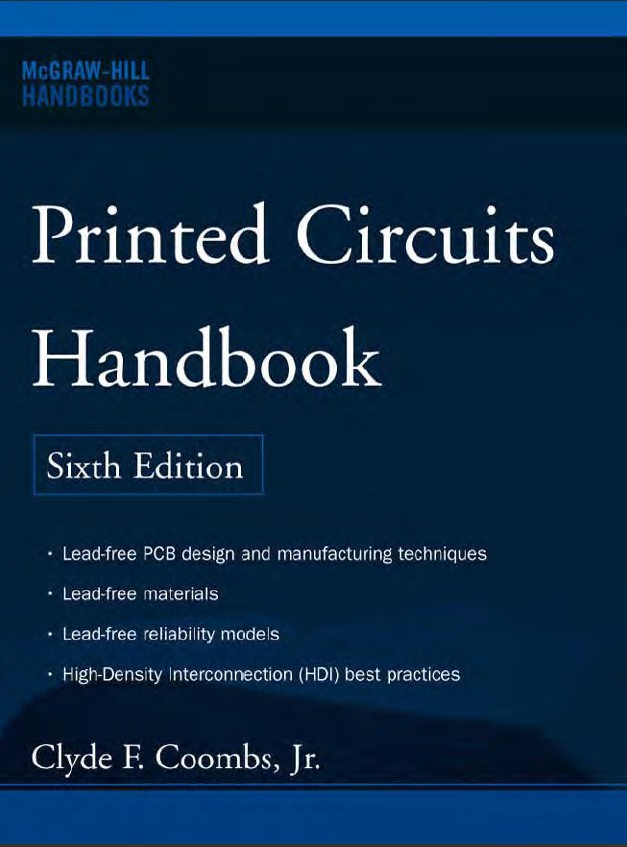本文包含原理图、PCB、源代码、封装库、中英文PDF等资源
您需要 登录 才可以下载或查看,没有账号?注册会员
×

PRINTED
CIRCUITS
HANDBOOK
Clyde F. Coombs, Jr. Editor-in-Chief
Copyright ? 2008 by The McGraw-Hill Companies. All rights reserved. Manufactured in the United States of America. Except as
permitted under the United States Copyright Act of 1976, no part of this publication may be reproduced or distributed in any form
or by any means, or stored in a database or retrieval system, without the prior written permission of the publisher.
0-07-151079-6
The material in this eBook also appears in the print version of this title: 0-07-146734-3.
All trademarks are trademarks of their respective owners. Rather than put a trademark symbol after every occurrence of a
trademarked name, we use names in an editorial fashion only, and to the benefit of the trademark owner, with no intention of
infringement of the trademark. Where such designations appear in this book, they have been printed with initial caps.
McGraw-Hill eBooks are available at special quantity discounts to use as premiums and sales promotions, or for use in corporate
training programs. For more information, please contact George Hoare, Special Sales, at george_hoare@mcgraw-hill.com or (212)
904-4069.
TERMS OF USE
This is a copyrighted work and The McGraw-Hill Companies, Inc. (“McGraw-Hill”) and its licensors reserve all rights in and to the
work. Use of this work is subject to these terms. Except as permitted under the Copyright Act of 1976 and the right to store and
retrieve one copy of the work, you may not decompile, disassemble, reverse engineer, reproduce, modify, create derivative works
based upon, transmit, distribute, disseminate, sell, publish or sublicense the work or any part of it without McGraw-Hill’s prior
consent. You may use the work for your own noncommercial and personal use; any other use of the work is strictly prohibited. Your
right to use the work may be terminated if you fail to comply with these terms.
THE WORK IS PROVIDED “AS IS.” McGRAW-HILL AND ITS LICENSORS MAKE NO GUARANTEES OR WARRANTIES
AS TO THE ACCURACY, ADEQUACY OR COMPLETENESS OF OR RESULTS TO BE OBTAINED FROM USING THE
WORK, INCLUDING ANY INFORMATION THAT CAN BE ACCESSED THROUGH THE WORK VIA HYPERLINK OR
OTHERWISE, AND EXPRESSLY DISCLAIM ANY WARRANTY, EXPRESS OR IMPLIED, INCLUDING BUT NOT LIMITED
TO IMPLIED WARRANTIES OF MERCHANTABILITY OR FITNESS FOR A PARTICULAR PURPOSE. McGraw-Hill
and its licensors do not warrant or guarantee that the functions contained in the work will meet your requirements or that its operation
will be uninterrupted or error free. Neither McGraw-Hill nor its licensors shall be liable to you or anyone else for any
inaccuracy, error or omission, regardless of cause, in the work or for any damages resulting therefrom. McGraw-Hill has no
responsibility for the content of any information accessed through the work. Under no circumstances shall McGraw-Hill and/or its
licensors be liable for any indirect, incidental, special, punitive, consequential or similar damages that result from the use of or
inability to use the work, even if any of them has been advised of the possibility of such damages. This limitation of liability shall
apply to any claim or cause whatsoever whether such claim or cause arises in contract, tort or otherwise.
DOI: 10.1036/0071467343
CONTENTS
Chapter 1. Legislation and Impact on Printed Circuits
Chapter 2. ELECTRONIC PACKAGING AND HIGH-DENSITY INTERCONNECTIVITY
Chapter 3. Semiconductor Packaging Technology
Chapter 4. Advanced Component Packaging
Chapter 5. Types of Printed Wiring Boards
Chapter 6. Introduction to Base Materials
Chapter 7. Base Material Components
Chapter 8. Properties of Base Materials
Chapter 9. Base Materials Performance Issues
Chapter 10. The Impact of Lead-Free Assembly on Base Materials
Chapter 11. Selecting Base Materials for Lead-Free Assembly Applications
Chapter 12. Laminate Qualification and Testing
Chapter 13. Physical Characteristics of the PCB
Chapter 14. The PCB Design Process
Chapter 15. Electrical and Mechanical Design Parameters
Chapter 16. Current Carrying Capacity in Printed Circuits
Chapter 17. PCB Design for Thermal Performance
Chapter 18. Information Formating and Exchange
Chapter 19. Planning for Design, Fabrication, and Assembly
Chapter 20. Manufacturing Information, Documentation,and Transfer Including CAM Tooling for Fab and Assembly
Chapter 21. Embedded Components
Chapter 22. Introduction to High-Density Interconnection (HDI) Technology
Chapter 23. Advanced High-Density Interconnection (HDI) Technologies
Chapter 24. Drilling Processes
Chapter 25. Precision Interconnect Drilling
Chapter 26. Imaging
Chapter 27. Multilayer Materials and Processing
Chapter 28. Preparing Boards for Plating
Chapter 29. Electroplating
Chapter 30. Direct Plating
Chapter 31. PWB Manufacture Using Fully Electroless Copper
Chapter 32. Printed Circuit Board Surface Finishes
Chapter 33. Solder Mask
Chapter 34. Etching Process and Technologies
Chapter 35. Machining and Routing
Chapter 36. Bare Board Test Objectives and Definitions
Chapter 37. Bare Board Test Methods
Chapter 38. Bare Board Test Equipment
Chapter 39. HDI Bare Board Special Testing Methods
Chapter 40. Assembly Processes
Chapter 41. Conformal Coating
Chapter 42. Solderability: Incoming Inspection and Wet Balance Technique
Chapter 43. Fluxes and Cleaning
Chapter 44. Soldering Fundamentals
Chapter 45. Soldering Materials and Metallurgy
Chapter 46. Solder Fluxes
Chapter 47. Soldering Techniques
Chapter 48. Soldering Repair and Rework
Chapter 49. Press-Fit Interconnection
Chapter 50. Land Grid Array Interconnect
Chapter 51. Acceptability and Quality of Fabricated Boards
Chapter 52. Acceptability of Printed Circuit Board Assemblies
Chapter 53. Assembly Inspection
Chapter 54. Design for Testing
Chapter 55. Loaded Board Testing
Chapter 56. Conductive Anodic Filament Formation
Chapter 57. Reliability of Printed Circuit Assemblies
Chapter 58. Component-to-PWB Reliability: The Impact of Design
Variables and Lead Free
Chapter 59. Component-to-PWB Reliability: Estimating Solder-Joint
Reliability and the Impact of Lead-Free Solders
Chapter 60. Process Waste Minimization and Treatment
Chapter 61. Flexible Circuit Applications and Materials
Chapter 62. Design of Flexible Circuits
Chapter 63. Manufacturing of Flexible Circuits
Chapter 64. Termination of Flexible Circuits
Chapter 65. Multilayer Flex and Rigid/Flex
Chapter 66. Special Constructions of Flexible Circuits
Chapter 67. Quality Assurance of Flexible Circuits
PRINTED CIRCUITS HANDBOOK.pdf |
|
 |手机版|MCU资讯论坛
( 京ICP备18035221号-2 )|网站地图
|手机版|MCU资讯论坛
( 京ICP备18035221号-2 )|网站地图